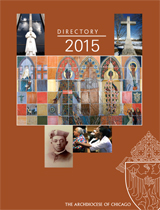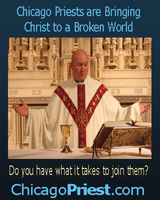March 30, 2008
In baptism, the Lord gives us his greatest gift
In the last lines of Matthew’s Gospel, the risen Jesus instructs his disciples to “Go, therefore, and make disciples of all nations, baptizing them in the name of the Father, and of the Son and of the Holy Spirit” (Mt 28:19).
This mandate has a sense of urgency and necessity because the ultimate fulfillment and destiny of all human beings is to be in communion with God and one another.
We recall his prayer to the Father: “So that they may all be one, as you, Father, are in me and I in you, that they also may be in us” (Jn 17:21). Unless we become “other Christs” it is impossible for human beings to realize the intimate bond with God that Jesus wishes and prays for.
The Catechism of the Catholic Church defines baptism as: “The first of the seven sacraments, and the ‘door’ which gives access to the other sacraments. Baptism is the first and chief sacrament of forgiveness of sins because it unites us with Christ, who died for our sins and rose for our justification” (CCC 867).
It is also one of the sacraments of initiation. “Baptism, confirmation and Eucharist constitute the ‘sacraments of initiation’ by which a believer receives the remission of original and personal sin, begins a new life in Christ and the Holy Spirit and is incorporated into the church” (CCC 867).
The sacrament of baptism makes it possible for us to be born as Christians or “other Christs” — as sons and daughters of God and temples of his Holy Spirit, all made possible through Christ. This explains why the church is ordered to baptize people of all nations in the name of the Trinity.
But how does baptism makes us children of God?
To explain the “how” of baptism we must draw our attention, as always, to the person of Jesus Christ. Jesus’ mission from the Father was to reconcile a sinful humanity to God. The mission of saving humanity came about through his incarnation as a man: to be like us in all things but sin, and then to die for our sakes and be raised on the third day. When Christ destroyed death, he restored us again to life in God.
St. Athanasius beautifully describes this profound mystery: “The Word [Jesus] was made man so that we might be made God.’’ What Athanasius adds to our understanding is that in order for us to live with God for all eternity, we must first become like his son.
‘In-spirited’
Baptism allows us to become like Christ through the reverse of incarnation. All human beings receive their physical traits from their parents, but since our physical generation ultimately leads to death, we need to become members of the Body of Christ — which leads to spiritual life, not death. Just as Christ was incarnated as a human being, we dare say that baptism contains this same dynamic, but in the opposite direction.
Unlike Christ, we start out by being incarnated as human beings and then become spiritual beings through baptism. Whereas the spiritual Word had to be made flesh, the human flesh of humanity needs this sacrament to become spiritually alive.
A useful term to describe this reality is that through baptism, we become in-spirited. To become in-spirited, or filled with the Holy Spirit, is what Athanasius may have meant when he taught that we are to become like God.
Crossing the threshold
At the beginning of the rite of baptism, the family is asked to congregate at the entrance of the church. Spiritual birth begins at the threshold between the world and the sacred. This important symbol draws the attention of the family to the fact that the child in their arms who has already been born into nature is about to be born into the supernatural as well.
Many older churches throughout the world represent this important line of demarcation with huge doors at the entrance, highlighting the difference between the profane world on one side and the world of the holy on the other.
While remaining at the entrance of the church, the priest or deacon asks the name of the child as well as the wishes of the parents. They respond by requesting “baptism” for their child. Said another way, the family wishes that their child be incorporated into the Body of Christ as a faithful son or daughter of God.
Anointing
The journey continues as the congregation and the child about to be baptized move to the baptismal font. Before the child is baptized, he or she is anointed with the oil of catechumens and God is asked to set the child free from original sin, preparing him or her to truly become a temple of the Holy Spirit.
The minister then asks God to give the child new life in abundance through water and the Holy Spirit. The blessing of the water recalls the great story of salvation, recalling the dawn of creation when God breathed on the waters, making them “the wellspring of all holiness,” continuing through the exodus of Israel through the Red Sea, Jesus’ baptism in the Jordan and concluding with Christ’s death on the cross and his glorious resurrection.
Water
Pouring water over the head of the child (or immersing him or her) is the action of the child entering a watery tomb, emulating the three days in the tomb Jesus experienced after his death. St. Paul reminds us: “We were indeed buried with him through baptism into death, so that, just as Christ was raised from the dead by the glory of the Father, we too might live in the newness of life” (Rom 6:4).
The child is again anointed, this time with sacred chrism. Anointing has ancient roots: All kings were anointed for the task set before them. As Christ was anointed Priest, Prophet and King, the newly baptized will be asked to live a life reflecting these characteristics.
Through his common priesthood, the baptized will be asked to sacrifice for the sake of the entire Body of Christ, just as Christ sacrificed his body for the church. He will also strive to be prophetic by sharing the Word of God with the world. Finally, the baptized is royalty as a new member of the kingdom of God.
White garment, candle
The child is then given a white garment to symbolize the dignity and purity of a child of God. “For all of you who were baptized into Christ have clothed yourself with Christ” (Gal 3: 27).
Finally, a lit candle is given to the family, symbolizing that the newly baptized no longer lives in the darkness of sin, but revels in the light of Christ, with the flame of faith burning brightly throughout his life.
During this Easter season, the Rite of Sprinkling the faithful with holy water at Mass reminds us of God’s greatest gift to us — his life. Reborn at Baptism, God now sees us as beloved sons and daughters, and is well pleased.
Fiala is with the John Paul II Newman Center at the University of Illinois-Circle Campus.
Pope Benedict XVI on baptism
During his homily at the Easter Vigil Mass in St. Peter’s Basilica on March 22, Pope Benedict XVI offered the following thoughts on the sacrament of baptism (for the full text of his homily, visit www.vatican.va):
“The Church expresses the inner reality of baptism as the gift of a new identity through the tangible elements used in the administration of the sacrament. The fundamental element in baptism is water; next, in second place, is light, which is used to great effect in the Liturgy of the Easter Vigil.
“Let us take a brief look at these two elements. In the final chapter of the Letter to the Hebrews, there is a statement about Christ which does not speak directly of water, but the Old Testament allusions nevertheless point clearly to the mystery of water and its symbolic meaning. Here we read: ‘The God of peace … brought again from the dead our Lord Jesus, the great shepherd of the sheep, by the blood of the eternal covenant’ (13:20).
“In this sentence, there is an echo of the prophecy of Isaiah, in which Moses is described as the shepherd whom the Lord brought up from the water, from the sea (cf. 63:11). Jesus appears as the new, definitive Shepherd who brings to fulfillment what Moses had done: he leads us out of the deadly waters of the sea, out of the waters of death.
“In this context we may recall that Moses’ mother placed him in a basket in the Nile. Then, through God’s providence, he was taken out of the water, carried from death to life, and thus — having himself been saved from the waters of death –— he was able to lead others through the sea of death.
“Jesus descended for us into the dark waters of death. But through his blood, so the Letter to the Hebrews tells us, he was brought back from death: his love united itself to the Father’s love, and thus from the abyss of death he was able to rise to life. Now he raises us from death to true life.
“This is exactly what happens in baptism: he draws us towards himself, he draws us into true life. He leads us through the often murky sea of history, where we are frequently in danger of sinking amid all the confusion and perils.
“In baptism he takes us, as it were, by the hand, he leads us along the path that passes through the Red Sea of this life and introduces us to everlasting life, the true and upright life. Let us grasp his hand firmly! Whatever may happen, whatever may befall us, let us not lose hold of his hand!
“Let us walk along the path that leads to life.”
Baptizing Chicago
According to the P.J. Kenedy Directory, the Archdiocese of Chicago had the following number of baptisms:
- 2007
1,680 Infants
1,640 Adults - 2006
1,710 Infants
1,500 Adults - 2005
1,650 Infants
1,500 Adults - 2004
1,831 Infants
1,670 Adults - 2003
2,328 Infants
1,739 Adults - 2002
2,245 Infants
1,515 Adults
 Catholic
New World - Newspaper for the Archdiocese of Chicago
Catholic
New World - Newspaper for the Archdiocese of Chicago Archdiocese of Chicago Directory
Archdiocese of Chicago Directory Oficjalne wydawnictwo Archidiecezji Chicago w języku polskim
Oficjalne wydawnictwo Archidiecezji Chicago w języku polskim